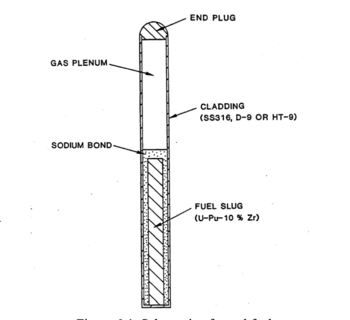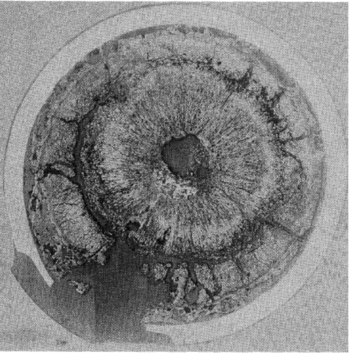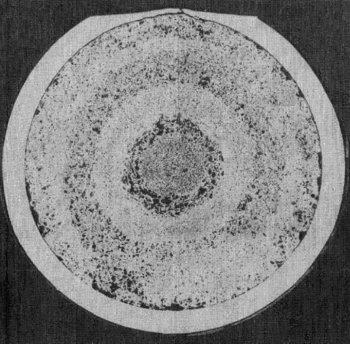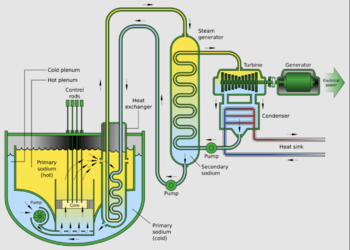Integral Fast Reactor: Difference between revisions
(→Choice of Fuel and Coolant: add link to Till & Chang on metal fuel and sodium coolant) |
m (→Waste Management: MWd -> MW-day) |
||
| Line 41: | Line 41: | ||
*Fast neutron reactors also burn most of the long-lived actinides that have led to worries about long-term disposal.<br> | *Fast neutron reactors also burn most of the long-lived actinides that have led to worries about long-term disposal.<br> | ||
To compare waste flows for reactors of various types, we need to distinguish between Spent Nuclear Fuel (SNF) that goes to [[Nuclear_waste_management|Interim Storage]] and High Level Waste (HLW) that must be permanently buried. To compare flows of fuel and waste for reactors of different sizes, we will normalize the numbers to grams per MegaWatt-day, and assume average power as 91% of rated maximum power.<br> | To compare waste flows for reactors of various types, we need to distinguish between Spent Nuclear Fuel (SNF) that goes to [[Nuclear_waste_management|Interim Storage]] and High Level Waste (HLW) that must be permanently buried. To compare flows of fuel and waste for reactors of different sizes, we will normalize the numbers to grams per MegaWatt-day, and assume average power as 91% of rated maximum power.<br> | ||
A typical 1000 MWe [[Pressurized_Water_Reactor|PWR]] produces 22 tonnes per year of spent fuel assemblies (66 grams per | A typical 1000 MWe [[Pressurized_Water_Reactor|PWR]] produces 22 tonnes per year of spent fuel assemblies (66 grams per MW-day).<ref name=PWRwaste/><br> | ||
A ThorCon 500 MWe [[Molten_salt_reactor|MSR]] should produce 13.43 tonnes of spent fuel salt per year (81 grams per MW-day).<ref name=MSRwaste/><br> | A ThorCon 500 MWe [[Molten_salt_reactor|MSR]] should produce 13.43 tonnes of spent fuel salt per year (81 grams per MW-day).<ref name=MSRwaste/><br> | ||
A 500 MWe IFR should produce 5 tonnes per year of heavy metal and fission product High Level Waste (30 grams per | A 500 MWe IFR should produce 5 tonnes per year of heavy metal and fission product High Level Waste (30 grams per MW-day).<ref name=IFRwaste/><br> | ||
Note: SNF from PWRs and MSRs can be reprocessed, and the final amount of HLW will depend on the details of that process. | Note: SNF from PWRs and MSRs can be reprocessed, and the final amount of HLW will depend on the details of that process. | ||
Revision as of 13:02, 14 October 2023
The Integral Fast Reactor (IFR) is Argonne Lab's best design,[1] a metal-fueled, sodium-cooled, pool-type [2] Fast Neutron Reactor, addressing all the issues raised in Nuclear_power_reconsidered (safety, waste management, weapons proliferation, and cost). "Integral" refers to the on-site reprocessing of the spent fuel. Some of the advanced reactor designs currently under development with venture capital are based on IFR/EBR-II technology -- GE's PRISM, Terrapower's Natrium, and ARC Clean Technology's ARC-100 reactor.



Choice of Fuel and Coolant
The IFR has a unique design for its fuel rods that accommodates much higher burnup than in light water reactors (LWRs) and also provides inherent safety if temperatures increase. To contrast IFR metal fuel with LWR oxide fuel, LWR fuel is "strong fuel, weak cladding", and IFR fuel is "weak fuel, strong cladding".
In standard light water reactor (LWR) fuel rods, the lower thermal conductivity of oxide (UO2) results in higher fuel temperatures that increase fission gas swelling. To avoid fuel-clad mechanical interaction that can cause cladding failure, there is a gap between the fuel and cladding. The gap is filled with helium gas for thermal bonding. If burnup is too high, however, the swelling and/or the oxide fuel cracking from thermal stresses will cause mechanical contact and strain the cladding to failure. These problems have been addressed in LWR fuel designs, but maximum burnup is limited by these effects to typically 5-6% of the total energy in the fuel.
In metallic IFR fuel, the fuel thermal conductivity is much larger than it is for UO2, so the fuel temperature and consequent fission gas swelling are more moderate. Fission gas more readily escapes the fuel meat and accumulates in the plenum above the fuel without unduly increasing the fuel rod internal pressure. As in LWR fuel, there is a radial gap between fuel and cladding, but the gap is filled with liquid metal sodium and has much higher thermal conductivity. Because metal fuel is weaker than UO2, mechanical contact with the clad is less consequential. The IFR fuel rod is illustrated in Figure 1.
In oxide-fueled LWRs clad with zirconium alloy, two chemical effects are disadvantageous. First, as happened at Fukushima, if the cladding temperature becomes too high in the presence of water, the zirconium alloy (used because of its low neutron capture cross section) rapidly oxidizes, weakening the cladding and producing hydrogen gas. Second, in the event of a cladding breach, the oxide fuel meat reacts with water and corrodes. In the IFR, parasitic fast neutron capture in cladding is far lower than parasitic thermal neutron capture in LWR cladding, so steel cladding can be used without adversely impacting the neutron economy. Steel does not suffer the rapid oxidation or hydrogen generation at high temperature that zirconium alloys do. If there is a cladding breach, fission products entering the coolant are bound there rather than released.
The thermal expansion coefficient of metallic fuel provides a negative reactivity feedback. If the fuel temperature increases, the fuel and coolant both expand, increasing neutron leakage from the core and thereby reducing the neutron chain reaction naturally. In other words, the temperature and power reactivity feedback coefficients are negative -- the hallmark of a stable system.
See chapter 5 CHOOSING THE TECHNOLOGY in Till & Chang, 2011 for more on the choice of metal fuel and sodium coolant.
The Fuel Cycle
As in other fission reactors, the spent fuel is a mixture of uranium, trans-uranics, fission products, and fuel material diluents. In LWRs, recycling fuel material more than one time becomes impractical, but the IFR’s fast neutron spectrum makes repeated recycling entirely feasible.[6] The IFR fuel cycle chemistry, pyroprocessing, is the "Goldilocks" chemistry -- good enough to recycle the materials into the reactor again, but not so selective as to make the recycled material attractive for diversion for a nuclear weapon. It uses electrochemical deposit of the recycle material on a cathode in a molten salt bath, rather like the re-deposit of lead on the electrode in a lead-acid battery.
The recycle system demonstrated at Argonne National Laboratory over the decades is a batch process that does not require hundreds of miles of piping containing concentrated nitric acid bearing radioactive material, so it is expected to be substantially cheaper than the aqueous reprocessing used outside of the United States.[7] Recycle facilities could economically service a cluster of IFR reactors co-located at one site, as was the case with EBR-II at Argonne-West.
Safety
The safety of the IFR design is ensured by several features:
1) The metal fuel, a low melting point alloy of U-Pu-Zr, will melt if the rod ever gets too hot. The fuel then expands upward in the steel cladding, shutting down the fission reactions (see Figure 1). The IFR is "walk away safe".
2) Many of the fission products bind chemically with sodium, reducing the risk of fission product release if there is fuel failure.
3) Convection and thermal inertia in the large pool of molten sodium will easily handle the decay heat after a shut-down (see Figure 2).
4) The reactor vessel has no penetrations below the top of the pool, eliminating the possibility of sodium leakage.
5) There is no high pressure or any water near the reactor vessel.
6) The reactor vessel is not filled solid, allowing for thermal expansion and contraction during operation.
7) The space above the sodium pool is filled with argon gas so that air never contacts the sodium.[8]
Full-scale reactor tests were conducted at Argonne National Laboratory (West) in Idaho (now Idaho National Laboratory), in which the primary coolant pump was stopped with the reactor running at full power. All safety systems were disabled, and the control rods were held fully withdrawn. These "unprotected loss-of-flow tests" simulate the extreme scenario where all safety systems and operator actions have failed.
The chain reaction was terminated by core expansion, and the core was cooled by natural circulation, without fuel damage or radioactive leakage.[9]
Waste Management
- Fuel rods have an advantage over molten salt fuels in that the fission products are contained in the rod. This means a smaller volume of Spent Nuclear Fuel (SNF). Rods are easy to identify and count, which may be advantageous in preventing diversion.
- Fast neutron reactors have an advantage over moderated reactors in that higher fuel burnup means more energy for a given amount of spent fuel.
- Fast neutron reactors also burn most of the long-lived actinides that have led to worries about long-term disposal.
To compare waste flows for reactors of various types, we need to distinguish between Spent Nuclear Fuel (SNF) that goes to Interim Storage and High Level Waste (HLW) that must be permanently buried. To compare flows of fuel and waste for reactors of different sizes, we will normalize the numbers to grams per MegaWatt-day, and assume average power as 91% of rated maximum power.
A typical 1000 MWe PWR produces 22 tonnes per year of spent fuel assemblies (66 grams per MW-day).[10]
A ThorCon 500 MWe MSR should produce 13.43 tonnes of spent fuel salt per year (81 grams per MW-day).[11]
A 500 MWe IFR should produce 5 tonnes per year of heavy metal and fission product High Level Waste (30 grams per MW-day).[12]
Note: SNF from PWRs and MSRs can be reprocessed, and the final amount of HLW will depend on the details of that process.
Weapons Proliferation
The chemistry of the IFR fuel recycling process does not allow extraction of weapons-grade material at any point in the cycle. Many of the radioactive rare earth fission products stay in the recycled fuel material. This makes the material unattractive from a nuclear weapons material diversion standpoint -- it is too radioactive, contains non-fissile uranium, and is processed either in a highly radioactive argon-gas-atmosphere hot cell or as fully formed highly radioactive fuel elements. Further chemical separation and isotopic enrichment would be required, a situation not different in kind from starting with unprocessed fuel. So the IFR adds little or nothing to proliferation risk.[13]
In countries not licensed for fuel processing, return of the spent fuel to a secure location could be handled as for any other reactor with solid fuel rods. Rods are easy to count, and the number in transit at any one time can be small enough to avoid theft of a large quantity.
Cost
- No enormous pressure vessel with 6-inch steel walls.
- No huge containment building with 6-foot thick, steel reinforced, nuclear-grade concrete walls.
- No expensive safety systems to respond to accidents that happen only in PWRs.
- Metal fuel reprocessing is expected to be substantially cheaper than aqueous reprocessing of oxide fuels.
- Much lower uranium mining costs because essentially all of the uranium is consumed, rather than 0.6%.
Notes and References
- ↑ PLENTIFUL ENERGY The Story of the Integral Fast Reactor, Charles Till and Yoon Il Chang, 2011.
- ↑ The alternative "loop-type" is necessary in standard Pressurized Water Reactors. A low pressure coolant allows a larger "pool-type" reactor vessel capable of absorbing all the heat in an emergency shutdown. See Till & Chang, Section 5.4 The Reactor Configuration Choice.
- ↑ Schematic of the metal fuel rod. Fig.6.1 in Till & Chang, Chapter 6 IFR Fuel Characteristics.
- ↑ Oxide fuel (9% burnup) Fig.6.5 in Till & Chang, Chapter 6 IFR Fuel Characteristics.
- ↑ Metal fuel (12% burnup) Fig.6.6 in Till & Chang, Chapter 6 IFR Fuel Characteristics.
- ↑ explanation needed
- ↑ add text with link here
- ↑ Sodium Reaction with Air and Water, Till & Chang, Section 7.12.
- ↑ Experimental Confirmations of Limited Damage in the Most Severe Accidents,Till & Chang, Section 7.10.
- ↑ add text with link here
- ↑ See the ThorCon Fuel Cylce diagram for calculated flows of fuel and spent fuel salt.
- ↑ add text with link here
- ↑ Nonproliferation Aspects of the IFR, Till & Chang, Chapter 12.
